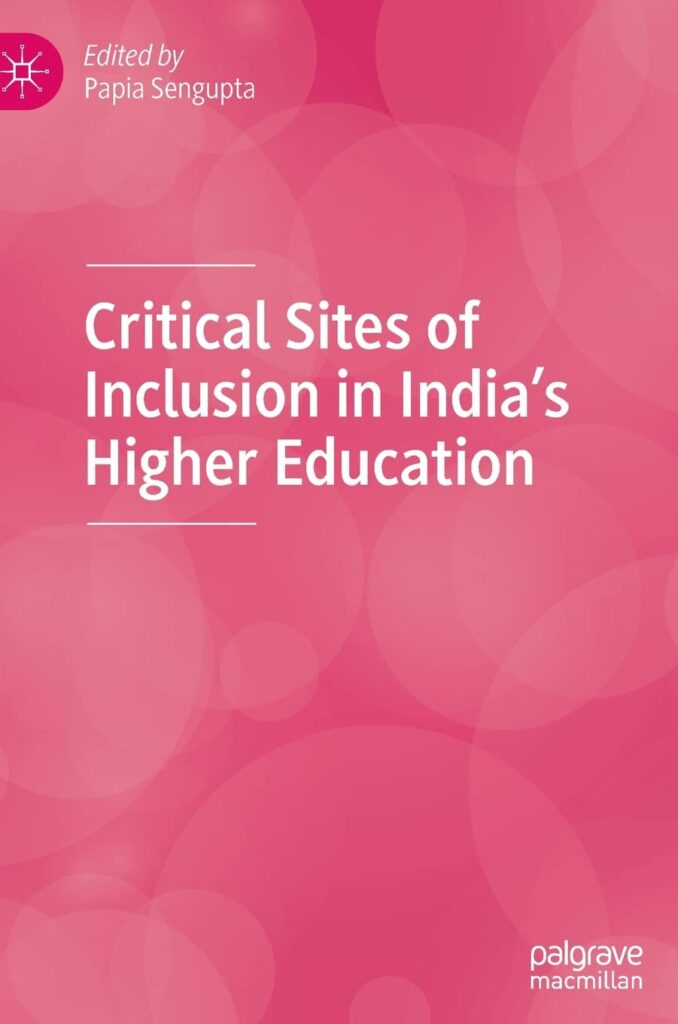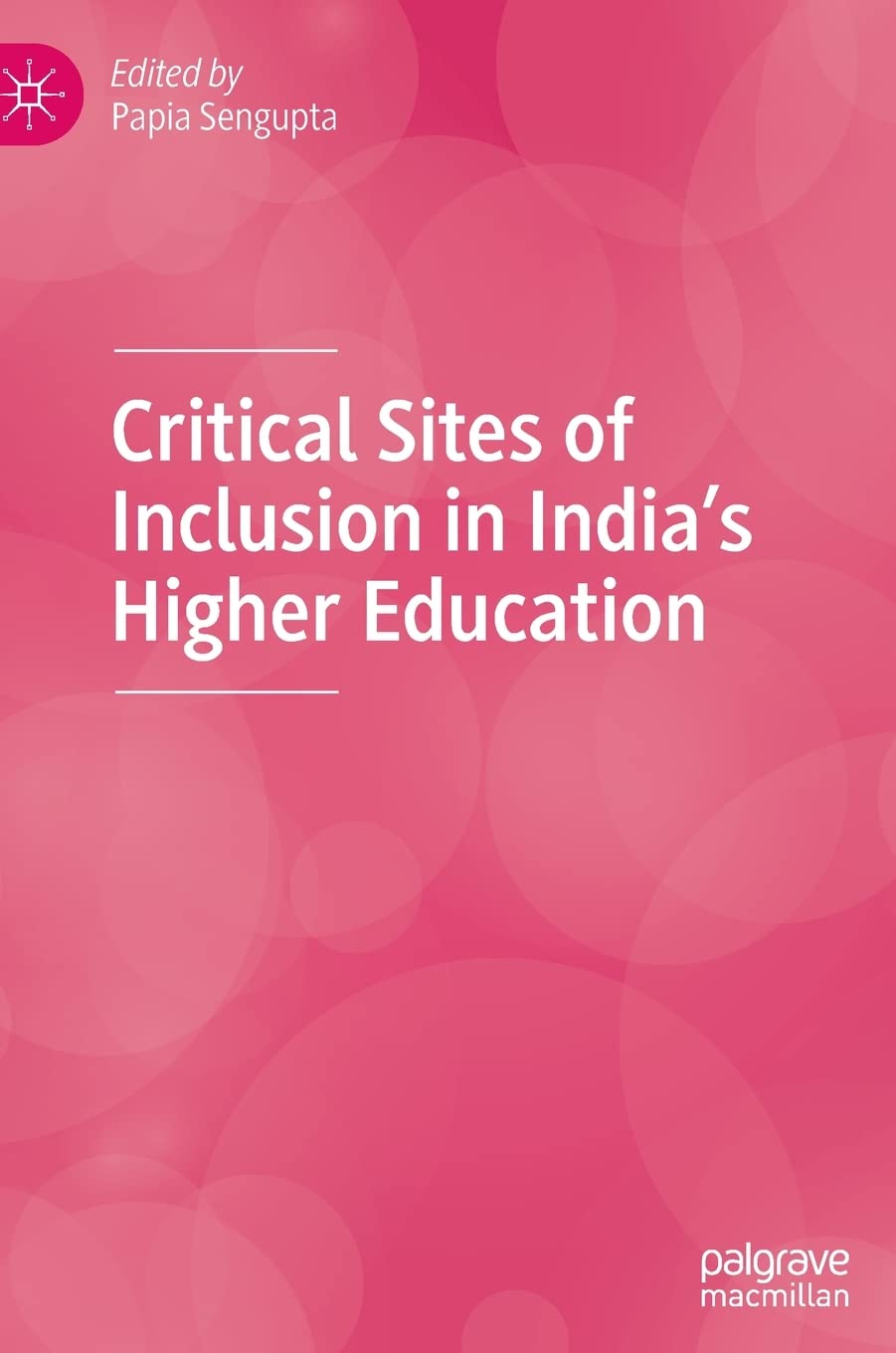
In democratic countries, education is regarded as a universal right of everyone. This is facilitated by the State through its various policies, mainly reservation which aims to ‘include’ people from diverse backgrounds in educational spaces. Therefore, a thorough discussion of the idea of inclusion is rendered important. In Critical Sites of Inclusion in India’s Higher Education (published by Palgrave Macmillan in 2022), Papia Sengupta does this by providing a multilayered analysis of various sites wherein inclusion is necessary and exclusion is rampant, mainly at the level of Higher Education (HE). Understanding inclusion not just as ‘getting in’ but as ‘getting in as equal’, the book demands the readers to look beyond reservation policies and focus on curriculum, pedagogy and socio-cultural attitudes to have a holistic understanding of the term.
The theme of the first chapter is the attack on public universities due to the neoliberal market rationality. This chapter kind of sets the tone for the entire book since it throws light on the commodification of education that has happened due to the intervention of market forces and neoliberalism mainly in public universities. It talks about how we are moving away from the idea of social welfare and equality towards rapid economic growth. Such ideas assert that expecting inclusion in higher education is a moot concept since market rationality takes it further away from such a cause. With the assault on critical thinking, curriculum, and academic freedom, neoliberalism views education not as a public good anymore but as a commodity which can capitalized for profit. This nullifies the idea of social justice. Further, such a notion gives lesser significance to social science and allied disciplines since they are not conducive to economic growth. Neoliberalism focuses on skills and not on knowledge hence there’s an increase of disciplines which can be useful in the labour market.
Minority Educational Institutions (MEIs) are another site where the question of inclusion is often negotiated with the state. The next chapter deals with this specific idea. The discussions by the Constituent Assembly on the rights of minorities led to the identification of various minority communities, without any specific definition of who a minority can be. Under such circumstances, the author looks at various Supreme Court cases that interpret these rights of minorities mainly in terms of ‘admissions, administration, affiliation, and state recognition as well as identification of minority institutes as minority-established institutions’ (2022, 48). These cases such as the Kerala Education Case of 1957 or St. Stephen’s College case of 1991 and many more serve as sites of contestation and inclusion that determine the extent of minority rights in India.
Along similar lines, the next chapter deals with the idea of minority education – Madrasah education in Bengal. It identifies the madrasah not only as a provider of religious education but also as a source of Muslim communities’ identity and culture. The author, here outlines the various types of Madrasahs found in Bengal imparting education till post-graduate level and how they have undergone various reforms due to various modernization programs to include religious education along with worldly affairs. These reforms have been crucial in the inclusion of the Muslim community mainly in Bengal wherein their socio-economic condition is extremely low. However, it still calls for bridge programs and other resources which can help students studying in Madrasahs to transition to various universities and prepare them for job markets.
In this chapter, the author highlights the issue of language as a site of exclusion. By looking at English Language courses at engineering institutions and other universities, the author claims that these courses are literature-based, leaving no scope for the use of language and thereby developing any communication skills. This chapter raises important questions on curriculum structure and pedagogy used by teachers in HEs that assume a certain level of language proficiency among students. This acts as a barrier for students belonging to disadvantaged groups who don’t have basic language skills by the time they leave school. Without proper grammatical knowledge and communication skills, such students get excluded from working in various professional and academic settings. The Englishization of HEs has created a ‘washback effect’ (2022, 85) on school education where the number of English medium schools has increased but there are hardly any resources for ensuring their functioning.
The chapter on Disability highlights the change within academia in perceiving disability. Moving from the medical or charity model that treats disabled people as inferior and who need care, the social model of disability now treats them as equal citizens. Hence, rather than segregating disabled people and advocating different education for them, this chapter highlights how we have adopted inclusive education through various national level and international level policies. However, how far the implementation of these policies is at the ground level is another game altogether. By focusing on visual disability, this chapter highlights the problems that these students face when they move from the school to the college level because of the dearth of books, special educators and even lack of required skills by the college professor. In the end, the chapter persuades the reader to look beyond their own social biases and highlights how stakeholders such as family, community and peers along with teachers and administrators help in creating an environment where inclusive education is possible.
The next chapter evokes a definition of inclusion that’s generally ignored. Coming from her personal experience, the author highlights what it means to be included in academia mainly for women. This chapter educates the reader that true inclusion in higher education doesn’t remain within the confines of the classroom but also involves access to any such space beyond it where learning can happen. This involves anything as remote as staying late in college to work on any project. This chapter highlights the gendered institutional norms such as hostel timings and other non-formal but equally gendered mechanisms that hinder women’s true participation in academia and stop them from identifying with their true potential or capabilities.
Sexuality can be seen as another site of exclusion in HE. The author asserts the importance of looking at school education, not only HE when understanding the LGBTQIA+ community since ‘coming out’ can happen quite early where one requires a supportive community to grow and understand oneself. The focus here is on an exhaustive idea of inclusion that is not just limited to the admission process but involves restructuring various institutional policies, curricula, textbooks, pedagogy and sensitization of teachers. While student bodies in universities have helped represent issues of queers, there remains quite a gap at the level of policies and administration.
The last chapter raises important questions regarding inclusivity within HE till now. The author further provides an assessment of the NEP 2020 by focusing exclusively on the idea of inclusion. The anomalies between the recommendations in NEP 2020 and the actions of the government are highlighted by the author. For instance, NEP 2020 proposes a Gender Inclusion Fund that can provide quality education to girls and transgenders; yet the Central Government has significantly reduced the funding for girls’ education in the budget of 2021-2022 (2022, 176). Similarly, the idea of grouping all minorities into one category – Socio-Economically Disadvantaged Groups (SEDGs) without any prior discussions seems quite puzzling to the idea of inclusion, since there has been some rationale for reservation for these different groups of minorities. NEP 2020 also talks about commercialization of education, which through the lens of inclusion seems unachievable, even though the document specifies that private institutions must disclose themselves as philanthropic institutions.
In the light of what can be termed as the ‘lynching of public universities’ (2022, 179), this book serves as an important reminder of how university spaces in contemporary times have become restrictive spaces curbing down on any form of discussions and dissent. In such a time, it is imperative to have discussions on the idea of inclusion and what it means to various groups who have been fighting for the right to be included. And this book serves the purpose of bringing the discussion on inclusion to the front.
***
Garima Rath is a PhD research scholar at the Centre for the Study of Social Systems (CSSS), Jawaharlal Nehru University (JNU), New Delhi.
